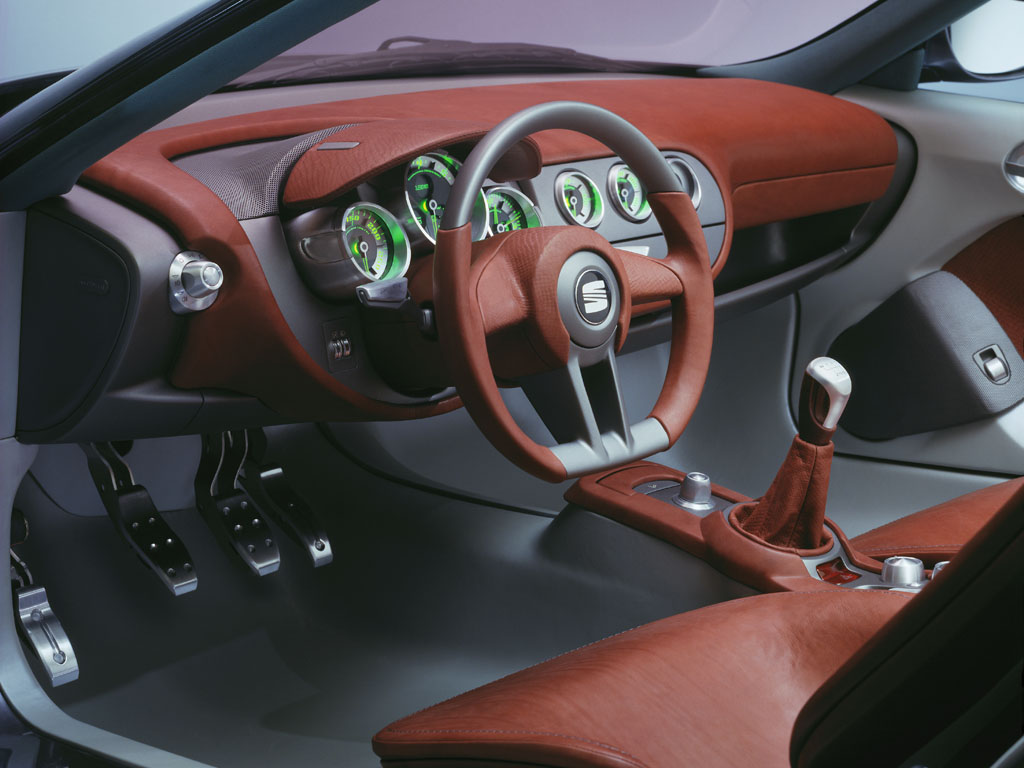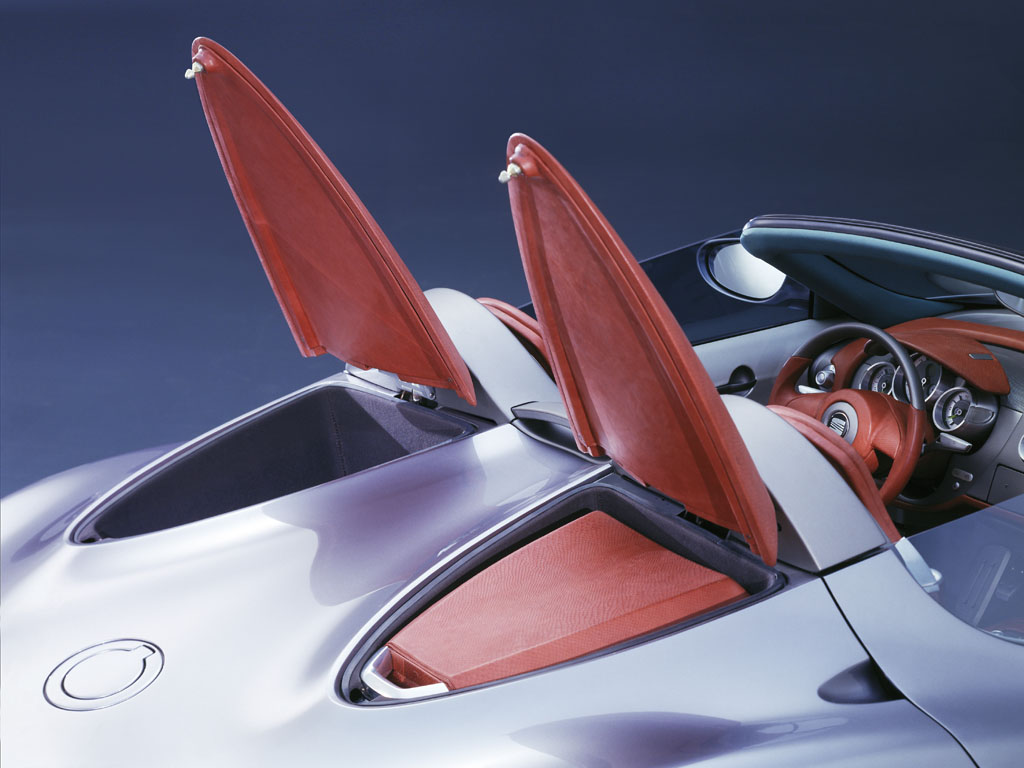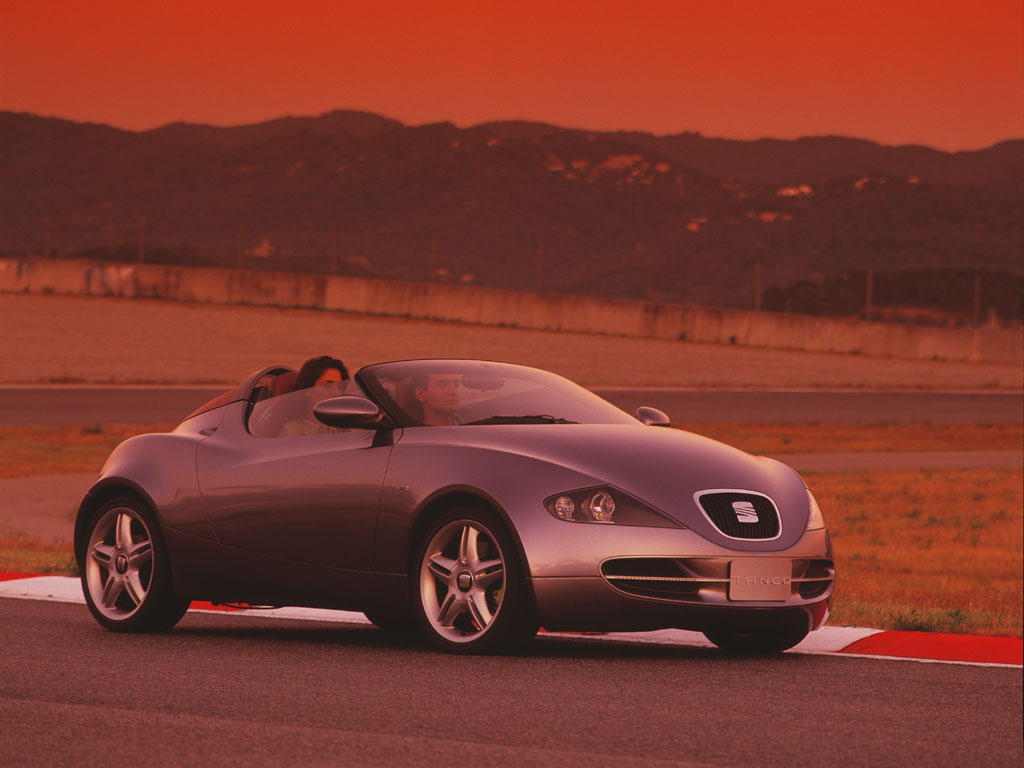2001 Seat Tango Concept
The SEAT Tango concept is a daring proposal that combines strength, simplicity, vital energy and sportiness in a design aimed at capturing these emotions. It goes beyond mere technical tricks or futuristic fantasies. Instead it interprets the essence of ’50s and ’60s sports cars from a 21st Century viewpoint but without resorting to unnecessary retro elements.
Conceived as an authentic spider, the SEAT Tango is expressive and innovative. The passenger compartment and chassis merge into one. Primary materials and textures, sheet metal and structure: everything comes together to create a compact body with fluid, muscular lines expressing a vital energy whether moving or standing still.
Although the seat itself is fixed, it’s not difficult to achieve the correct driving position, for the steering column and instrument dials are adjustable for height and reach. The same applies to the pedal box, which can be adjusted to the perfect position via a control on the central console. Add in seat cushion height adjustment and the perfect driving position can be tailored for every driver.
Beneath the skin of the SEAT Tango, there’s a sophisticated tubular structure developed by teams at the SEAT Technical Centre and SEAT Sport – in effect, it’s an evolution of the World Rally Car safety cage. Within this structure nestles a 180 hp 1.8 turbocharged engine with a six-speed gearbox and a refined chassis. Such highly efficient sports suspension and the powerful brake system are in perfect harmony with the agility and performance expected of an authentic sports car.
High levels of safety have been central to the development of Tango: it features latest generation ABS, electronic stability control, traction control, twin front airbags, side airbags, seat-belt pretensioners, a progressive deformation structure and a central passenger cell which is highly resistant to front, side and rear impacts.
The SEAT Tango has a top speed of 235 km/h and sprints from 0 to 100 km/h in only 7 seconds, allowing the driver and passenger to enjoy the sensations of speed, wind and engine roar in equal measure. This is a machine conceived by – and for – those who love cars in their purest state.
Open character
The SEAT Tango is a natural extrovert. Its passenger compartment mingles with, blends into and becomes part of the chassis, interlacing forms, materials, textures and colours. It combines the exterior and interior as one.
The surface of the aluminium chassis, painted in a metallic Tango Grey effect, breaches the passenger compartment and becomes part of the interior.
At the same time, the material used to dress other surfaces – such as the dashboard, seats, backrests and headrests – explodes out of the cockpit, to cover the several storage compartments located behind the seats. The rust coloured ‘snakeskin’ used on these elements is, in fact, specially waterproofed leather which has also been used for the set of cases designed exclusively for the luggage compartment.
In going back to basics, all unnecessary panels and embellishments have been omitted from Tango. Essential parts of the structure – the safety arch, dashboard crossbeam, the undersides of the seats and the steering wheel column – have been deliberately left visible with a rough metallic finish, like bare aluminium bones forming the car’s skeleton.
The controls, on the other hand, are of polished aluminium as are the instrument panel dials, pedal box and footrests. So, too, are the enormous 18 inch wheels, through whose spokes can be seen the powerful Brembo brakes, painted the colour of cast aluminium.
The seats are individual SEAT cushions and backrests, and the interiors of the doors are covered by simple panels. The sound system’s main speakers are hidden behind a mesh grille, while the tweeters lie at either side of the headrests, looking like air vents.
A sun-worshipper and no stranger to the wind, a spider is patient and ascetic. Following this philosophy, the Tango needs no ostentatious accessories, not even from an aerodynamic point of view. The only concession is a small spoiler, integrated into the design of the rear bodywork.
Luxury items such as a convertible roof simply do not exist⦠although a pair of fighter pilot-like helmets with integrated visors and leather lining are standard. There are plans for an optional, detachable Kevlar hard-top, for winter weather conditions, however.
Wide rear wings add to the muscular look of the SEAT Tango, although the silhouette shuns complications and is stripped of elements that would otherwise disrupt the purity of the line. Thus the electric door handles blend into the door profile and the bumpers are perfectly integrated in the overall shape of the car. The rear is dominated by a centrally-mounted twin exhaust pipe in glossy aluminium.
Indeed, the only chrome element to be found on the entire car is the radiator grille at the front framing the SEAT logo.
The art of light
At first glance, the new SEAT Tango captivates with the purity of its lines, though the treatment of the lights might surprise the casual observer. The headlamps are stripped of any special housing and are open to view.
Whether dipped or on main beam, the Xenon lamps automatically follow the direction in which the car is being driven. They also adapt to driving conditions, adjusting their brightness for open road or motorway driving and for the weather conditions.
The front fog lamps are so not obvious, though. They take the form of a series of light emitting diodes located in the central moulding of the air intake vents. This optimises the volume of cooling air to the engine, at the same time as integrating them into the front end design.
The rear end features more interesting ideas. The brightness of the rear lights can also be adjusted to suit to the driving conditions. But that’s not all. A system of filters lit by fibre optics make it possible to do away with defined areas for the different lighting functions. The entire light strip can be a rear light, a brake light or an indicator.
Riding the wind
Behind the grey tinted windscreen is the analogue instrument panel is lit by a special phosphorescent effect: the tachometer is the main dial and dominates the centre of the instrument panel. It includes battery level and oil temperature indicators and is flanked by the speedometer and the chronometer clock. Together these make up the set of dials attached to the steering column. To the right there are three further dials for the water temperature, fuel gauge and a series of warning lights.
The seats in the SEAT Tango are fixed, so the perfect driving position is achieved thanks to the combined steering column/instrument binnacle which is adjustable for height and reach and to the moveable pedal box which adjusts to the length of the driver’s legs. Adjustment is electric and operated via a control on the central console. Finally, the seat cushion is height adjustable.
The remaining vehicle controls are located on the central console, and include an air conditioning system to give maximum driving comfort.
Built for speed
The SEAT Tango delivers good vibrations even when at idle while a gentle pace is enough to enjoy the sensation of the wind in your face. But its engine and chassis have been developed for more demanding use and deliver impressive performance.
The vehicle is built for speed, and its 180 hp provides a rush of adrenaline. It takes 7 seconds to reach 100 km/h from rest, and Tango continues accelerating to cover a kilometre in 28 seconds. Top speed has been clocked at 235 km/h, but the way in which it handles corners is also impressive thanks to its sports chassis which has been tuned by the competition department of SEAT Sport.
All of this leads to an extraordinary level of active safety, and is complemented by the powerful brake system with ABS, electronic stability programme (ESP), and traction control system (TCS). Passive safety elements include twin front and side airbags.
Proven chassis solutions
Extreme simplicity has always been a fundamental characteristic of a genuine Spider – a vehicle frugal to the point of austerity and one that does not resort to frivolity to satisfy its driver. Tango is no different. It has an exceptional heritage, being based on the running gear of the most powerful, sportiest versions of the SEAT Ibiza.
The chassis, suspension and brakes easily handle the power developed by the 1.8 litre turbocharged engine. It delivers its 180 hp to the front wheels via an efficient six-speed manual gearbox. Not only does this engine provide outstanding outright performance, but high levels of torque guarantee flexibility even at low revs: peak torque of 235 Nm is available from just 2,100 rpm all the way to 5,000 rpm. As a result, the SEAT Tango copes with both gentle and more aggressive driving demands with aplomb.
Front suspension relies on an independent McPherson strut system, with shock absorber coil units, lower wishbones and an anti-roll bar anchored to a sub frame assembly.
The rear axle incorporates a degree of self steer to ensure precise handling, even on the most sinuous mountain road. This is where the work carried out by SEAT Sport is most notable.
Safe and resistant
A car with no roof forces engineers to develop a structure that maintains levels of rigidity and safety expected of a ‘tin-top’. As a result, the SEAT Tango includes some interesting technical solutions.
The structure of the vehicle warrants special attention. It features a tubular shell known as the Safety Skeleton, with a design based on the framework of a World Rally Car safety cage. It is made up of three basic elements.
At the front, the sub-chassis is strengthened by the dashboard crossbeam and windscreen frame, forming a forward arch. Two reinforcements from the rear of the structure make the central part more rigid.
At the rear the tubular framework is joined to the seat structure and is strengthened with a series of buttresses as on a cathedral, which distribute tension in several directions. At the same time, this solid sub-chassis houses the rear suspension elements.
The result is a car with greater torsional rigidity than the Ibiza Cupra itself. Firmer shock absorbers and coil springs and a very low centre of gravity allow the SEAT Tango to move with the swift agility of a sports car under all driving conditions.
Story by Seat
In Detail
| submitted by | Richard Owen |
| engine | Inline-4 |
| displacement | 1781 cc / 108.7 in³ |
| power | 134.2 kw / 180.0 bhp @ 5600 rpm |
| specific output | 101.07 bhp per litre |
| bhp/weight | bhp per tonne |
| f brake size | mm / in |
| r brake size | mm / in |
| wheelbase | 2200 mm / 86.6 in |
| length | 3685 mm / 145.1 in |
| width | 1714 mm / 67.5 in |
| height | 1181 mm / 46.5 in |
| gear ratios | :1 |
| top speed | ~235 kph / 146.0 mph |
| 0 – 60 mph | ~7.0 seconds |











